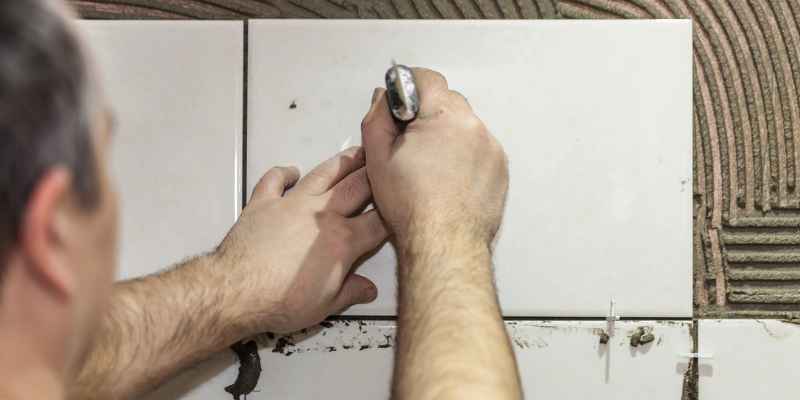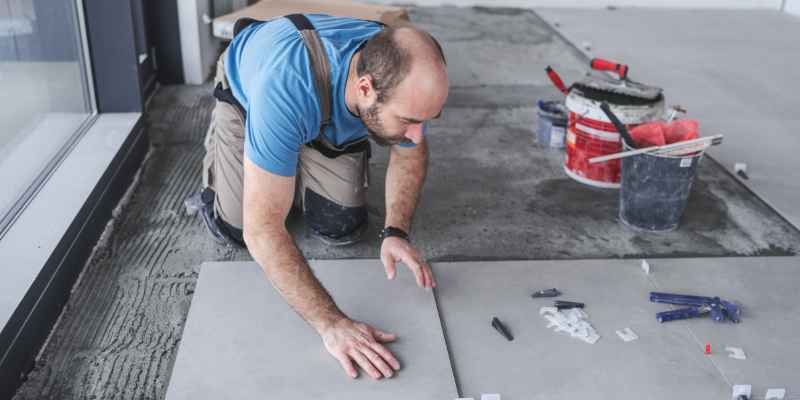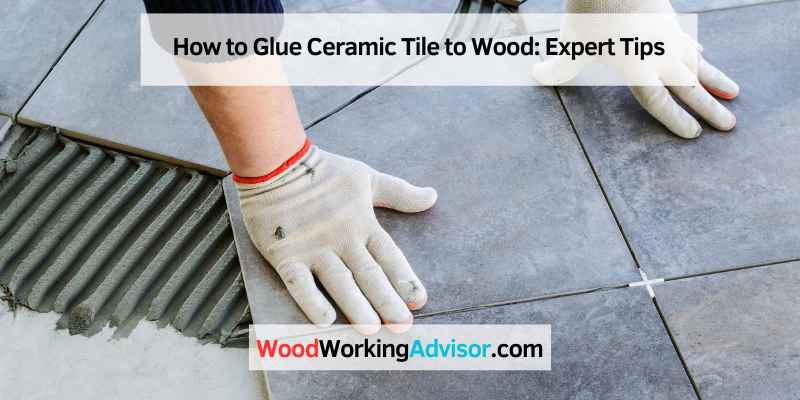To glue ceramic tile to wood, use an epoxy-based tile adhesive for the best results. Epoxy adhesives offer durability, moisture resistance, and strong bonding for outdoor environments.
Alternatively, consider using a super glue gel for precise application on porous surfaces like ceramic, porcelain, and wood. Make sure to choose a glue that can withstand extreme temperatures and vibrations. It’s important to ensure the wooden subfloor has enough rigidity and select a flexible tile adhesive when tiling on wood surfaces to prevent cracking.
Silicone sealants are also a good option for bonding ceramics, due to their flexibility and long curing time.
Recommended Adhesive For Tile To Wood
When gluing ceramic tiles to wood surfaces, using an epoxy-based tile adhesive is recommended for its durability, moisture resistance, and bonding strength. Epoxy adhesives are ideal for outdoor applications and offer a strong, long-lasting bond between ceramic tiles and wood, ensuring a reliable and lasting installation.
Epoxy-based Tile Adhesive
Epoxy adhesives are the recommended choice for affixing ceramic tiles to wood due to their exceptional qualities and performance.
Benefits Of Epoxy Adhesives
- Excellent durability
- Moisture resistance
- Strong bonding strength
- Suitable for outdoor environments
One of the best adhesive options for tile to wood applications is an epoxy-based adhesive. This type of adhesive is known for its exceptional durability, resistance to moisture, and strong bonding capabilities, making it ideal for outdoor projects.
Best Glue For Ceramic To Wood
For a secure bond between ceramic and wood, consider using an epoxy-based tile adhesive. Epoxy adhesives offer durability, moisture resistance, and strong bonding, ideal for both indoor and outdoor applications. Another option is Loctite Super Glue Power Flex Control Gel, known for precision application and strong, lasting hold on various surfaces like ceramic and wood.
and flex, it’s important to use the right glue for a strong and long-lasting bond. One highly recommended adhesive for ceramic to wood is the Loctite Super Glue Power Flex Control Gel. This super glue gel provides numerous benefits, ensuring a secure and durable attachment between these two materials.
Loctite Super Glue Power Flex Control Gel
One of the best glues for ceramic to wood is the Loctite Super Glue Power Flex Control Gel. This powerful adhesive is specially designed to bond porous surfaces like ceramic, porcelain, and wood. Its gel consistency allows for precision application, ensuring that you can apply the glue exactly where you need it without any running or dripping.
This super glue gel offers excellent durability, moisture resistance, and bonding strength. Whether you’re gluing ceramic tiles to a wood surface indoors or outdoors, this adhesive provides a strong and long-lasting hold that can withstand extreme temperatures and vibration.
Some key benefits of using Loctite Super Glue Power Flex Control Gel for ceramic to wood bonding include:
– Precise application: The gel formula allows for easy and precise application, ensuring that you can apply the glue exactly where you need it without any mess.
– Strong bond: This glue creates a strong bond between ceramic and wood, ensuring that the tiles will stay in place even in high-traffic areas or under heavy loads.
– Moisture resistance: The adhesive is moisture-resistant, making it suitable for both indoor and outdoor use. It can withstand exposure to water, humidity, and other environmental factors without weakening the bond.
– Temperature resistance: It can withstand extreme temperatures, making it a great choice for outdoor projects where the materials may be exposed to heat or cold.
– Vibration resistance: The strong bond created by this adhesive can withstand vibration, making it ideal for applications where there may be movement, such as in vehicles or machinery.
In conclusion, when it comes to gluing ceramic tiles to wood, the Loctite Super Glue Power Flex Control Gel is an excellent choice. Its precise application, strong bond, moisture resistance, temperature resistance, and vibration resistance make it the best glue for ceramic to wood bonding. With this adhesive, you can ensure a secure and long-lasting attachment between the two materials.
Installation Of Tiles On Wood Surface
When it comes to gluing ceramic tile to a wood surface, it is important to clean the wood thoroughly and apply a highly elastic, ready-to-use tile adhesive directly from the bucket. Spread the adhesive with the appropriate trowel, spray water over the surface, and press the tiles into the mortar.
Avoid using too much glue and consider using an epoxy-based adhesive for outdoor environments for better durability, moisture resistance, and bonding strength.
Preparation And Cleaning
Before starting the installation of ceramic tiles on a wood surface, it is essential to ensure that the wood is clean and free from any debris or dust. Brush away any dirt and dust with a dry paint brush; avoid using water as it can affect the wood. Once the wood is clean, proceed with the next steps.
Applying Tile Adhesive
Choose a suitable tile adhesive for wood surfaces. An epoxy-based tile adhesive is recommended for its durability, moisture resistance, and strong bonding strength, especially for outdoor environments. Spread the mortar using the appropriate trowel depending on the tile format. Apply the tile adhesive straight from the bucket and ensure complete coverage on the wood surface. Spray water over the mortar’s surface before installing the tiles to aid in the adherence process.
Tile Placement And Pressing
With the tile adhesive sufficiently applied, proceed with placing the ceramic tiles on the wood surface. Press the tiles into the mortar to ensure a secure bond. Allow the tile adhesive to set adequately before moving on to the grouting process.
Grouting Process
Once the tile adhesive has set, it’s time to start the grouting process. Use a suitable grout that complements the ceramic tiles and the wood surface. Ensure that the grout is applied evenly and thoroughly between the tiles, providing a polished and finished look to the installation.
Tips For Gluing Mosaic Tiles To Wood
Preparing Flat Substrates
Before gluing mosaic tiles to wood, ensure that the wood substrate is flat and free from any dirt or dust. Use a dry paintbrush to remove any debris. Avoid using water as it can affect the wood. Also, ensure the wood surface is dry before proceeding.
Choosing The Right Glue
One recommended adhesive for affixing ceramic tiles to wood is an epoxy-based tile adhesive. This type of adhesive offers excellent durability, moisture resistance, and bonding strength, making it suitable for both indoor and outdoor environments. Another suitable option for a precise application is Loctite Super Glue Power Flex Control Gel, especially for porous surfaces like wood, ceramic, and porcelain. Its strong bond can withstand extreme temperatures and vibrations.
Applying The Glue
When applying the adhesive, follow the manufacturer’s instructions carefully. Use an appropriate trowel to spread the adhesive evenly over the wood surface. Ensure that the adhesive layer is uniform and free from any lumps or air pockets to ensure a strong bond with the mosaic tiles.
Avoiding Excessive Glue
It’s crucial not to use excessive glue when attaching mosaic tiles to wood. Applying too much glue can lead to uneven surfaces and affect the overall finish. It’s essential to strike the right balance, ensuring the adhesive is adequate for a strong bond without being excessive.
Considerations For Tiling On Wood Surfaces
To glue ceramic tile to wood, ensure the wooden subfloor is rigid enough to support the tiles. Opt for an epoxy-based tile adhesive for durability and moisture resistance. Properly clean the wood surface and apply the adhesive straight from the bucket using an appropriate trowel for even spreading.
Ensuring Subfloor Rigidity
Check that the wood subfloor is stable to prevent tile cracking.
- Inspect for any signs of damage or movement in the wood.
- Address any issues with leveling or structural integrity before tiling.
Selecting Flexible Tile Adhesive
Choose an adhesive that can accommodate the natural expansion and contraction of wood.
- Opt for flexible tile adhesives, such as epoxy-based options, for durability.
- Ensure the adhesive offers moisture resistance for longevity in varying environments.
Consider options like Loctite Super Glue Power Flex Control Gel for precise application on ceramic tiles to wood.
Remember, a strong bond and proper adhesive selection are key to a successful tile installation on wood surfaces.

Silicone Sealants For Ceramic Tiles
When gluing ceramic tiles to wood, it’s essential to use the right adhesive to ensure a strong and lasting bond. An epoxy-based tile adhesive is recommended for its excellent durability, moisture resistance, and bonding strength. Consider using silicone sealants for ceramics to affix the tiles securely to wood surfaces.
Benefits Of Silicone Sealants
Silicone sealants offer numerous benefits when it comes to gluing ceramic tiles to wood.
- Waterproof: Silicone sealants create a waterproof barrier, preventing water from seeping into the wood and causing damage.
- Durability: These sealants are highly durable and can withstand daily wear and tear, ensuring long-lasting adhesion between the tiles and wood.
- Flexibility: Silicone sealants are known for their flexibility, allowing for natural movement and expansion of the wood without compromising the bond with the tiles.
- Resistance: They are resistant to moisture, temperature changes, and UV rays, making them suitable for both indoor and outdoor tile installations.
Applying Silicone Sealants To Ceramics
When it comes to applying silicone sealants to ceramics, it is important to follow a few simple steps for a successful bond.
- Clean and Prepare the Surface: Ensure that both the ceramic tiles and the wood surface are clean, dry, and free from any dirt, dust, or debris. Use a dry paintbrush to brush away any particles.
- Apply the Silicone Sealant: Using a caulk gun, apply a thin and even layer of silicone sealant on the back of the ceramic tiles. Be sure to apply enough pressure to ensure proper adhesion.
- Press and Hold: Place the tiles onto the wood surface, pressing firmly to create a strong bond. Hold the tiles in place for a few seconds to allow the sealant to set.
- Clean Up Excess Sealant: Use a damp cloth or sponge to remove any excess sealant around the edges of the tiles, creating a neat and professional finish.
- Allow to Cure: Give the sealant ample time to cure and fully bond. Follow the manufacturer’s instructions for the recommended curing time, which can vary depending on the brand.
By following these simple steps and using silicone sealants specifically designed for ceramic tiles, you can ensure a secure and long-lasting bond between the tiles and wood surface.
Tips For Gluing Ceramic Tiles To Wood
Looking to glue ceramic tiles to wood? Follow these expert tips for a successful bond. Clean the surfaces thoroughly, apply epoxy-based tile adhesive for durability, and grout once the adhesive is set. For outdoor projects, opt for a super glue gel designed for porous surfaces like wood and ceramic.

Using Gorilla Glue
Gorilla Glue is a reliable option for bonding ceramic tiles to wood surfaces. Follow these simple steps when using Gorilla Glue:
- Clean the wood surface thoroughly before applying the glue.
- Apply a small amount of Gorilla Glue on the back of the ceramic tile.
- Press the tile firmly onto the wood surface and hold it in place until the glue sets.
- Avoid excess glue to prevent any spillage or mess.
Preventing Wood Movement
To ensure a strong and lasting bond between ceramic tiles and wood, it’s important to prevent wood movement. Follow these tips:
- Choose an epoxy-based tile adhesive for outdoor durability and moisture resistance.
- Avoid excessive use of glue to maintain a clean and secure bond.
- If using super glue gel like Loctite Super Glue Power Flex Control Gel, ensure precise application.
Frequently Asked Questions On How To Glue Ceramic Tile To Wood
What Is The Best Adhesive For Tile To Wood?
For bonding tile to wood, an epoxy-based tile adhesive is recommended due to its durability and moisture resistance.
What Is The Best Glue For Ceramic To Wood?
The best glue for ceramic to wood is an epoxy-based tile adhesive. It provides excellent durability, moisture resistance, and bonding strength. Another option is Loctite Super Glue Power Flex Control Gel, which is ideal for ceramic, porcelain, and wood surfaces.
It offers a strong bond that can withstand extreme temperatures and vibrations.
Can You Stick Ceramic Tiles To Wood?
Yes, you can stick ceramic tiles to wood using epoxy-based tile adhesive for durability and strength. Ensure the wood subfloor has enough rigidity and choose flexible tile adhesive to prevent cracking. Silicone sealants can also be used for a flexible bond.
What Kind Of Glue Sticks To Ceramic Tile?
An epoxy-based tile adhesive is best for affixing ceramic tile to wood, offering durability, moisture resistance, and strong bonding.
Conclusion
To securely bond ceramic tiles to wood, choose epoxy-based tile adhesive for strength and durability. Ensure your wood surface is clean and ready for tiling, apply the adhesive evenly, then press the tiles firmly. Opt for precision super glue gel for porous surfaces like wood and enjoy a strong, lasting hold.


